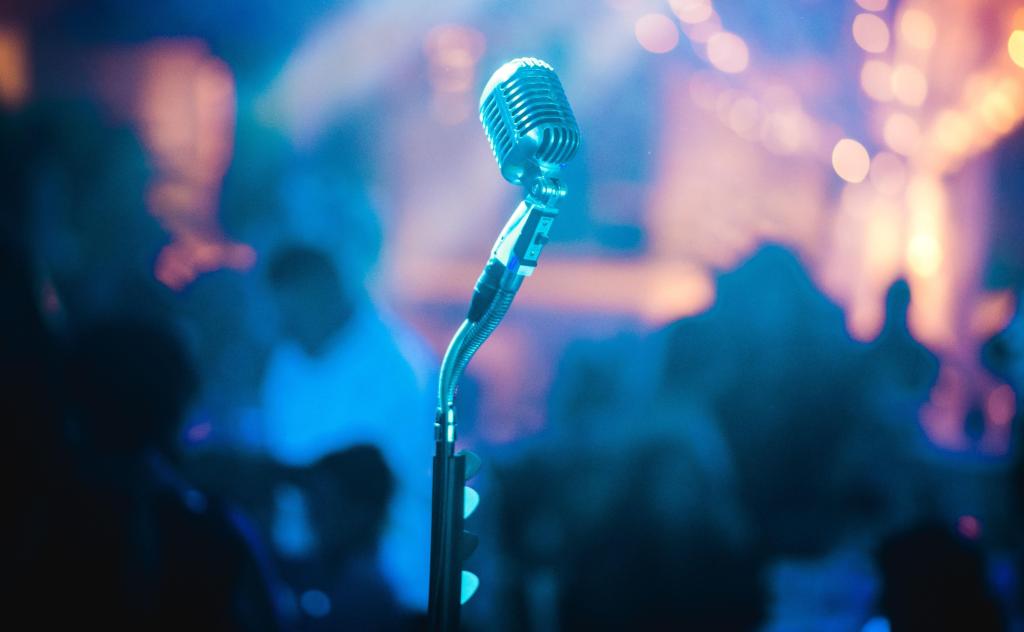Trick One: Movement
From the moment you are called up to perform, your audience is watching you. Your movements are part of your show.
You move with confidence directly to the microphone. Feet are spread just a touch wider than your shoulders. Shoulders are back. Hands are free. You breathe in. You breathe out. Centre yourself. Breathe in and … speak. Boom! This is what I call Standard Power Walk.
Or… what happens if your name is called and, instead of going directly to mic, you are seated in the audience? Your poem/story just begs for you to be one of the crowd.
You look around as the audience gets anxious waiting for you to fill the empty stage. You stand, pull the cordless mic from behind your back and speak. (Hopefully you’re in a venue with a follow spot (a spotlight that can be moved to follow you), the house lights are up or the lighting person is in on the trick so they have a special spot set up for you. You still want to be seen. You can make your way to the stage while you perform, or you can stay in the audience. Step around them. Stand on a chair. This is the ultimate we-are-all-passengers-on-the-same-bus opener.
How about you slide, commando style, across the stage? Do a forward roll? Run, skip? Rip open your yellow raincoat … You see where this is going?
You might not get the cool lighting guy, or the cordless mic, or the follow spot. Assess the room, figure out what will surprise the crowd and fit the context of your poem. Then … Your name is called … and ENTRANCE – the big movement that kicks off your stage time.
This is a show. You are the sole character and performer. How will you fill this space? It has to be with more than just words. So movement, at minimum, will be the Standard Power Walk entrance combined with gesture. Those hands have to move with purpose and intention. You punctuate your points with action. You grab onto the reins and gallop as you describe your first horse ride. Move your hand slowly up your body and above your head, and pop your hand open like a sunflower as you sing about your luscious garden.
Emotional hand waving or throwing your arms wide is okay for a bit of emphasis but the good stuff is planned, choreographed and meaningful. Pull back the bow. Flip through the pages. Yes, okay, it may look like amateur mime sometimes, but people are listening, following the pictures and actions you are painting with words. You will add to the impact of your imagery with conscious gestures.
Trick Two: Sound effects
Your performance on stage is anything you can do with mouth and body. Right? This means you can sing, scream, whistle, stutter, go for a whole lot of onomatopoeia – bang, zoom, vroom – and experiment. Add vocal sound effects.
Also think about the loud and soft bits. This is called modulation, and it helps to emphasise your emotions. We all know that if someone shouts in a conversation they’re excited or angry – or the music is too loud. It means something. What could a whisper mean? Try long pauses. Why write ‘I laugh’ when you can just laugh? You can add all kinds of emotional interjections. Instead of saying ‘He picks up the glass’, just reach your hand out, grab the glass and guzzle.
Pitch refers to high and low notes – in music, or just in your speaking voice.
Please don’t finish every sentence on a higher note. Read these two sentences out loud:
Your statements sound like questions.
Your statements sound like questions?
Your statements, if you want them to resonate with confidence, should end on the same note as the rest of the words in the sentence, or on a lower note.
Of course you can play with this. A child-like voice is often represented as high; an old man’s voice, or a serious voice, is deep. Play with these notions. Find the musicality in your sentences.
You have this mad gamut of movement and sound available to you, so use it to bend expectations. The tricky thing here is maintaining an emotional connection with your audience. Ensure each tick and click is in context. People will be impressed if you walk on stage on your hands while belting an operatic aria into the mic, then deliver a poem completely unrelated to acrobatics and song. But they’ll see the opener as a trick unrelated to your work. You’d be better off advancing the story or the arc of your writing. Think of it like this: you’re watching a 3D film, and suddenly there’s a scene in an asteroid field. You just know the director threw it in to make you duck, because it didn’t fit the rest of the script. Heart rate up, yes. But it’s a cheap trick – let’s get back to the hero’s pending doom.
Sound, pitch and movement: use them in line with your purpose.

Cover for the forthcoming book by Miles Merrill and Narcisa Nozica
Trick Three: Speed
This is where you chooosssse to eeeelongaaate a liiine as you move your body like a robot running low on battery power. It’s the slow-mo setting as you lean back, lift one foot off the floor and stick your boot up your racist boss’s bum. It’s also the super-quick race to the finish line.
This is where you get to put rhythm into practice. You throw in some rhymes and speak to a fast beat:
Rain is seventeen year
Cicada plague
Ga-ga-ga-gone kamikaze
On my nylon A-frame.
A Ballina hurricane
spins in my racing brain.
Speaking quickly can also represent anxiety. If it’s done as a clear character, it’s great. But your audience might also hear this as your own anxiety. You are going to be full of adrenaline, which will cause you to speed up. You’ll have to consciously slow down, add pauses, and articulate and clearly pronounce each word. You might think you’re speaking too slowly but your audience will hear a normal conversational pace.
You want to articulate and pronounce each word. This relates closely to what we talked about with using concrete language – you’ve only got 2 or 3 minutes on stage. You have to tell a story with imagery and action instead of abstract language or your audience will tune out. Likewise, if your audience is missing lines because you’re rattling them off too quickly, they will stop listening. They may pick up a couple of key words, get the gist and applaud, but they’ll miss your message.
You have no replay button in a live event. Words wash into our ears and clear the way for the next wave of syllables. Give them time to be processed. On a recording, or in a song you sing at every concert, people will give you their ear more readily for sped-up language while they mine your verses for meaning. But in a live spoken-word setting, too fast just means tuned out. There is no music to carry the audience through your flood. There is no rewinding and playing again. You have to remember people are there to hear your content, not your beat. They haven’t read your book yet so they’re not reciting along with you.
This is an extract from Slam Your Poetry: Write a Revolution available in February from NewSouth Books.





